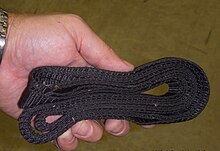Hose strap

A hose strap (also known as a rope hose tool) is a piece of firefighting equipment. It can be "a short length of rope with an eye loop at one end and a metal hook at the other"[1] or a piece of "flat nylon webbing sewn into a four-foot loop".[2] Such a tool is routinely carried by firefighters in their structural turnout gear as a standard piece of personal equipment.[3] While the variety with a metal hook may be more versatile, the nylon loop weighs less, is less expensive, and can be safely carried in a pocket. The hose strap has been a firefighting tool in common use since at least 1918,[4] and appears as early as 1898 in an inventory list of Seattle, Washington municipal firefighting equipment.[5]

While the terms may be used for a family of similar tools, they share a wide variety of established uses, including carrying un-charged fire hose,[2] opening doors,[6] closing doors,[7] securing hoselines,[8] dragging victims,[9] and even carrying boots.[3] The use that gives the tool its name, however, is securing a charged hoseline, allowing a firefighter to better control and maneuver the line while flowing water. To use a hose strap in that manner, a firefighter secures the tool to the hoseline three to five feet behind the nozzle, using either the hook or a girth hitch, and loops the other end of the tool around his or her opposite side shoulder.[10] Since the tool is attached several feet behind the firefighter, its use will not hinder a firefighter wearing a Self-contained breathing apparatus. For larger attack lines, such as a 2+1⁄2 inches (6.4 cm) hand line, second or third firefighters can use additional hose straps to secure the hose farther behind the nozzle operator, to provide additional leverage against the water pressure. Since multiple hose straps will typically be available to a team of firefighters, they can be used in combination to handle a variety of other tasks. For example, if a task requires greater length than that of a single hose strap, two hose straps may be connected via girth hitch.
References
- ^ Spadafora, Ronald R. (2007). McGraw Hill's Firefighter Exams. McGraw-Hill. p. 220. ISBN 0-07-147769-1. Retrieved 2008-09-06.
- ^ a b Bradford, George (2000). Structural Protection in the I-zone. PennWell Books. p. 19. ISBN 0-912212-95-0. Retrieved 2008-09-06.
- ^ a b Brennan, Thomas F. (2007). Tom Brennan's Random Thoughts. Fire Engineering Books. p. 22. ISBN 1-59370-112-8. Retrieved 2008-09-06.
- ^ Sandy, William C. (1918). "Organizing Fire Department at State Hospital". Hospital Management. Clissold Pub. Co. Retrieved 2008-09-07.
- ^ Seattle (Wash.). Comptroller's Office (1898-01-03). Annual Report of the Comptroller - City of Seattle, Washington. Comptroller. p. 78. Retrieved 2008-09-07.
- ^ Clark, William E. (1991). Firefighting Principles & Practices. PennWell Books. p. 115. ISBN 0-87814-920-1. Retrieved 2008-09-06.
- ^ Klaene, Bernard J. (2007). Structural Firefighting: Strategy and Tactics. Jones & Bartlett. p. 158. ISBN 0-7637-5168-5. Retrieved 2008-09-06.
- ^ Norman, John (1998). Fire Officer's Handbook of Tactics. PennWell Books. p. 65. ISBN 0-912212-72-1. Retrieved 2008-09-06.
- ^ International Association of Fire Chiefs (2007). Fundamentals of Fire Fighter Skills Workbook. Jones & Bartlett. p. 99. ISBN 0-7637-4259-7. Retrieved 2008-09-06.
- ^ Fornell, David P. (1991). Fire Stream Management Handbook. PennWell Books. p. 412. ISBN 0-87814-927-9. Retrieved 2008-09-06.